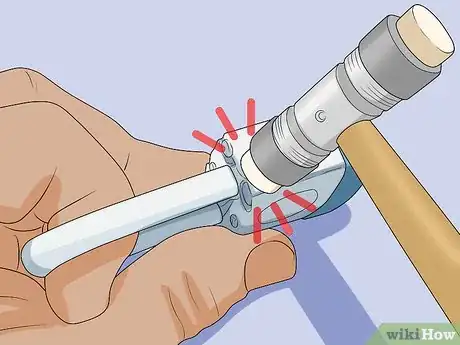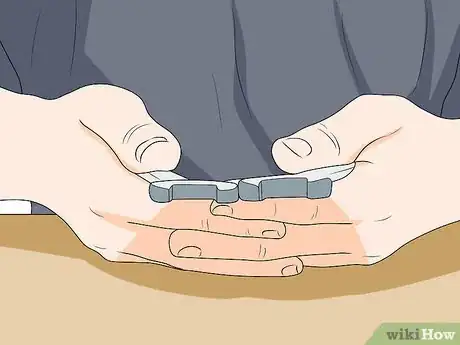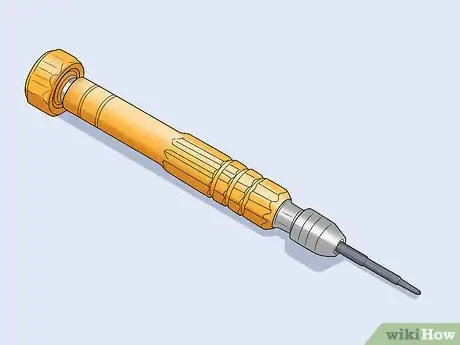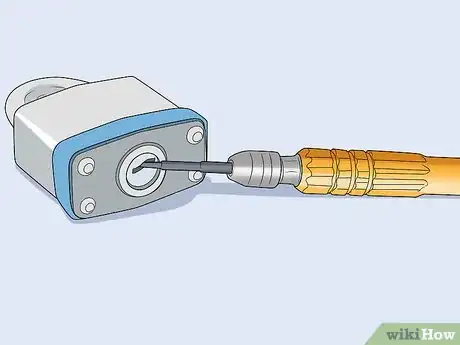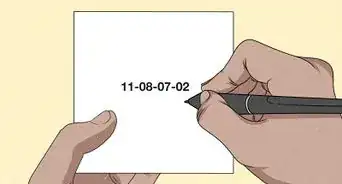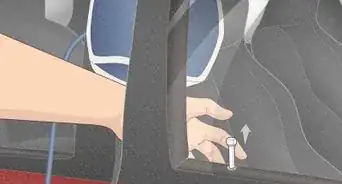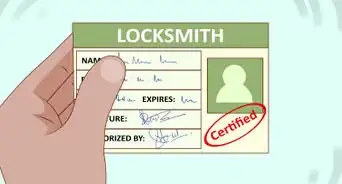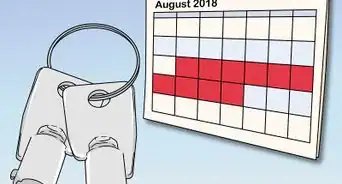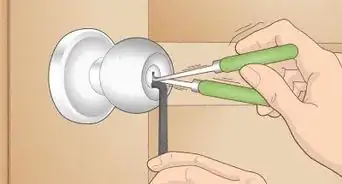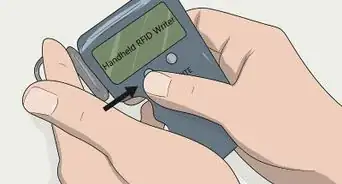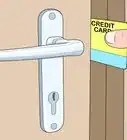This article was co-authored by wikiHow Staff. Our trained team of editors and researchers validate articles for accuracy and comprehensiveness. wikiHow's Content Management Team carefully monitors the work from our editorial staff to ensure that each article is backed by trusted research and meets our high quality standards.
There are 16 references cited in this article, which can be found at the bottom of the page.
This article has been viewed 475,215 times.
Learn more...
If you've misplaced the keys to a lock and can’t get to whatever it’s protecting, you may have no choice but to break it. Fortunately, it’s possible to bypass almost any basic commercial-grade lock with ease, provided that you have the right tools and a little know-how. A standard padlock, for instance, can be cracked using only a hammer, a screwdriver, or a pair of open-ended wrenches. There are also more creative solutions for dealing with especially tough locks like the kinds used to secure bikes, such as freezing the lock with a canister of compressed air and smashing it with a hammer.
Steps
Bumping a Padlock with a Hammer
-
1Pull up on the shackle to create tension. The simplest way to do this is to insert two fingers into the shackle loop and use them to force the shackle away from the top of the lock. This will put the locking pins inside the lock into the right position for a quick crack-job.[1]
- Make sure you’ve eliminated all excess slack from the shackle. If you don’t, you won’t be able to knock the lock loose, no matter how many times you hit it.
- Don’t try to grip the body of the lock itself—that’s where you’ll be aiming your hammer.
-
2Tap the side of the lock with a hammer or similar tool repeatedly. More specifically, you want to target the side that contains the fixed end of the shackle, as the pins are located just underneath. Pound the lock over and over again using quick, short strikes. Eventually, you’ll disengage enough of the pins to “bump” the lock open.[2]
- You can also use the handle of a screwdriver or another hard, blunt item if you don’t happen to have a hammer handy.[3]
Warning: Resist the urge to swing for the fences. It’s the constant movement of the pins that’s responsible for overriding the lock, not brute force. Teeing up will just make you more likely to hurt yourself.
Advertisement -
3Reuse your lock when you’re finished. The best part about coaxing a padlock open with a hammer is that it should still work like nothing ever happened afterwards, so long as you don’t hit it hard enough to damage any of the pins. As soon as you get done breaking your lock, give it a test run. If it fastens properly, hold onto it for future usage. If not, chuck it in the trash.
- This method can be useful if you need to remove your padlock without the keys but don’t want to destroy it in the process.
Breaking a Padlock with a Pair of Wrenches
-
1Get a hold of two open-ended wrenches. Any size wrench will do to the trick. In general, however, the bigger the head, the better the wrenches will work, as they’ll be able to exert more pressure on the lock.[4]
- It’s important that both wrenches be close to the same size in order to ensure that the force is evenly distributed to both sides of the shackle, or the U-shaped metal clasp that fastens the lock.[5]
-
2Hook the open ends of the wrenches over each side of the shackle. Once you have the wrenches in position, bring the handles as close together as you can. This should cause the two internal arms of the wrench heads to butt up against one another.[6]
- Try to position the wrenches right in the middle of the vertical shafts of the shackle. If they’re too high or too low, they may slip off once you start applying pressure.[7]
- Before you actually attempt to break the lock, give the handles of the wrenches a quick squeeze to make sure that they won’t slide, shift, or lose their grip on one another.
-
3Force the handles of the wrenches together until the shackle breaks in two. Push the handles together toward your midline as hard as you can. It may take quite a bit of muscular effort to actually snap the shackle, so be patient and don’t give up. When it does finally give way, it will break right down the middle.[8]
- It may help to choke up your grip on the handles so that you’re pushing with the flat part of your palms rather than the edges of your fingers.
Tip: If you’re working with a particularly large lock or small set of wrenches and the arms don’t quite touch, create a makeshift shim using a folded piece of paper or similar object and slip it between the arms to generate the necessary traction.[9]
-
4Fish out both halves of the shackle to remove the lock. Now that you’ve successfully snapped the shackle, all you have to do is pull out the broken pieces. You may need to twist or jiggle them a few times to get them to come free, as the ends will still be secured in the locking mechanisms inside the lock.[10]
- If the lock you’re breaking has a plastic body, you may be able to tear the shackle free in one piece.
- If you’ve squeezed and squeezed with all your might and still can’t get the shackle to budge, save your energy and try out another method, such as a few well-placed whacks with a hammer.
Jimmying a Tumbler Lock with a Screwdriver
-
1Find a screwdriver with a tip small enough to fit into the lock. If the tip is too wide, you won’t be able to get it into the keyhole, and your lock-breaking adventure will be over before it even gets started. The type of slender screwdrivers used to fix jewelry and eyeglasses will be perfect for most small and medium-sized locks.
Alternative: Gather together multiple screwdrivers so you’ll have a backup in case one doesn’t quite fit.
-
2Insert the tip of the screwdriver into the keyhole. Slide the screwdriver into the lock until you can’t get it in any further. If it won’t go in far enough to reach deep into the barrel of the lock, it’s most likely too big, which means you’ll need to try again with a smaller screwdriver.
- In a standard pin tumbler lock, the locking pins move up and down freely inside the body of the lock. Using a key to align the pins with the lock plug causes the lock to open.[11]
-
3Jiggle the screwdriver while thrusting it in and out of the lock. Slide the blade of the screwdriver back and forth slowly. At the same time, work the handle of the around at different angles to engage as many pins as possible. Most tumbler locks are designed to release automatically if a minimum number of pins are shifted correctly.[12]
- Avoid letting the screwdriver slip too far out of the lock. Doing so could cause you to start missing pins, effectively undoing the progress you’ve made.
-
4Continue jostling the lock until it springs open. If you manage to hit all of the right tumblers, the lock will pop open on its own. Until then, it will remain shut fast and refuse to budge. Don’t be discouraged if it takes a while to get the desired result—just keep wiggling and sliding. If you stick with it long enough, there’s a good chance that your patience will be rewarded.
- Be careful about performing this trick in public places. If someone sees you, they might think you’re breaking into something that’s not yours.
- If you’re not getting anywhere with your screwdriver, come back with a hammer or pair of wrenches and see if you have better luck.
Busting a Bike Lock Using Compressed Air
-
1Grab a canister of compressed air and a hammer. You can buy compressed air at any hardware store or home improvement center, as well as most supermarkets and drugstores. Chances are, you already have a hammer in your garage, tool box, or utility drawer.[13]
- The secret to breaking a lock with compressed air is that compressed air isn’t actually “air” at all—it’s a cooling gas known as difluoroethane, which freezes the lock and makes it brittle enough to break manually.[14]
Tip: A sledgehammer will offer far greater leverage and striking power than an ordinary hammer if you’re up against a hefty U-lock. Just make sure you use one with a head made of metal rather than rubber.
-
2Spray one end of the lock continuously for about 20-30 seconds. Focus the stream on the area where the shackle inserts into the collar of the lock. You may notice the metal appear to grow lighter in color or take on a frosted appearance by the time you’re finished.[15]
- Difluoroethane is cold enough to cause frostbite on exposed skin. Always wear gloves to protect your hands anytime you're working with compressed air.
- You need to use enough compressed air to cool the lock to a temperature of −13 °F (−25 °C) in order to weaken it enough to become breakable.[16]
-
3Bash the lock with the hammer until it breaks. It may take a few good hits to fracture the metal surrounding the locking mechanism, even if it’s reached the requisite −13 °F (−25 °C). Try to pinpoint each strike at the exact same spot to up your chances of success.[17]
- Keep in mind that your lock will no longer be functional once you break it. In most cases, the metal will actually shatter into pieces.
- This method also works on chain and cable locks, so you should be able to retrieve your bike no matter how you've secured it.[18]
Warnings
- Never attempt to break a lock that you don’t personally own. Interfering with a lock with the intention of stealing or gaining access to someone else's property is a crime, and could land you in hot water with the law.⧼thumbs_response⧽
Things You'll Need
Bumping a Padlock with a Hammer
- Hammer
- Screwdriver handle or similar object (optional)
Breaking a Padlock with a Pair of Wrenches
- 2 open-ended wrenches
- Makeshift shim (optional)
Jimmying a Tumbler Lock with a Screwdriver
- Small, slender screwdriver (like the kind used to fix jewelry and eyeglasses)
Busting a Bike Lock Using Compressed Air
- Canister of compressed air
- Hammer or sledgehammer
- Gloves
References
- ↑ https://www.youtube.com/watch?v=pU9MB5XPsp4&feature=youtu.be&t=34
- ↑ https://www.youtube.com/watch?v=pU9MB5XPsp4&feature=youtu.be&t=41
- ↑ https://www.csoonline.com/article/3010200/skip-the-picks-expert-uses-hammer-to-open-a-master-lock.html
- ↑ https://www.wideopenspaces.com/get-past-a-padlock-using-just-two-basic-tools/
- ↑ https://www.locksmiths.co.uk/security-advice/locksmith-terminology/
- ↑ https://www.youtube.com/watch?v=1jJP0CcuJyE&feature=youtu.be&t=17
- ↑ https://www.youtube.com/watch?v=rl8154zT67I&feature=youtu.be&t=11
- ↑ https://www.youtube.com/watch?v=rl8154zT67I&feature=youtu.be&t=22
- ↑ https://www.youtube.com/watch?v=1jJP0CcuJyE&feature=youtu.be&t=65
- ↑ https://www.youtube.com/watch?v=rl8154zT67I&feature=youtu.be&t=29
- ↑ https://www.sciencedirect.com/topics/computer-science/pin-tumbler-lock
- ↑ https://www.artofmanliness.com/2014/11/19/how-to-pick-a-lock-pin-tumbler-locks/
- ↑ https://www.zdnet.com/article/revealed-the-secret-technique-used-to-steal-bicycles/
- ↑ https://nj.gov/health/eoh/rtkweb/documents/fs/0715.pdf
- ↑ https://www.popsci.com/diy/article/2012-08/gray-matter-how-science-helps-bike-thieves
- ↑ https://www.zdnet.com/article/revealed-the-secret-technique-used-to-steal-bicycles/
- ↑ https://www.popsci.com/diy/article/2012-08/gray-matter-how-science-helps-bike-thieves
- ↑ https://www.youtube.com/watch?v=9j4DqevlIRY&feature=youtu.be&t=122
About This Article
One of the easiest ways to break a padlock is with a hammer. Start by inserting 2 fingers into the padlock's shackle loop and pull up on the shackle to create tension. Then, tap the side of the lock that contains the fixed end of the shackle with a hammer using quick, short strikes. Avoid hitting the lock with your full strength since the consistent tapping is what breaks it open, not brute force. Keep targeting this area with the hammer until the pins disengage enough for you to pull the lock open. You can also use the handle of a screwdriver or another hard, blunt item if you don’t happen to have a hammer handy! For tips on breaking open a padlock with 2 wrenches, keep reading!

